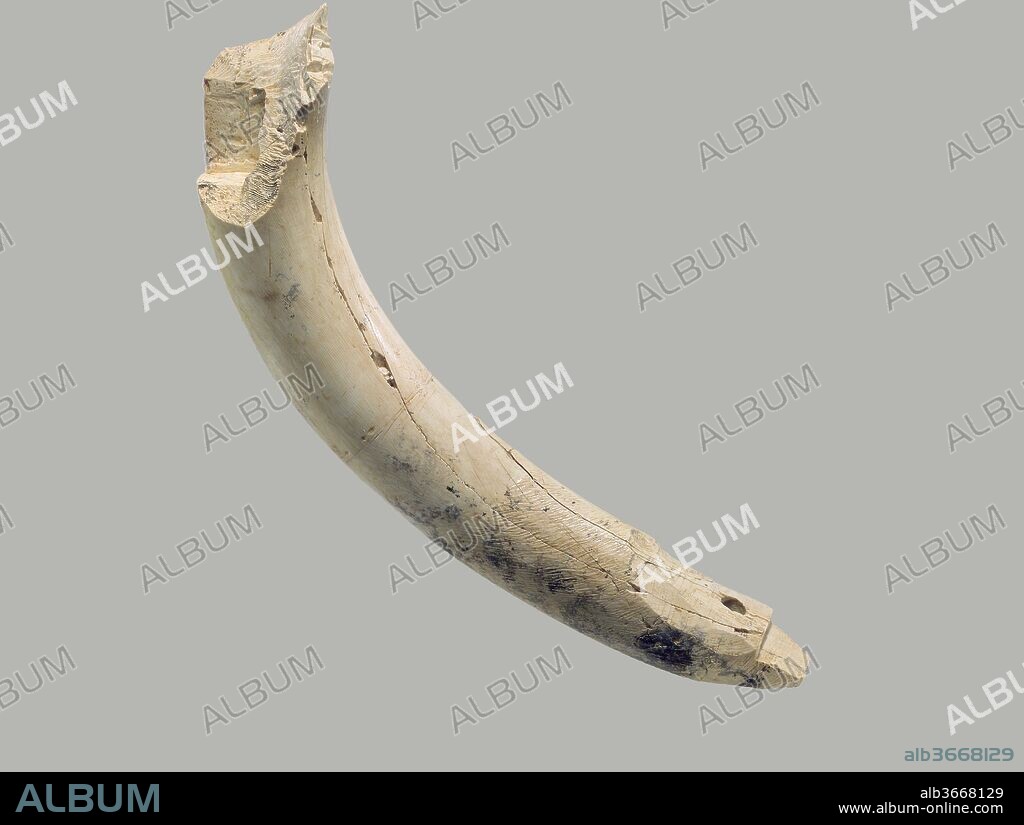alb3668129
Furniture element made from a hippopotamus incisor

|
Zu einem anderen Lightbox hinzufügen |
|
Zu einem anderen Lightbox hinzufügen |



Haben Sie bereits ein Konto? Anmelden
Sie haben kein Konto? Registrieren
Dieses Bild kaufen

Titel:
Furniture element made from a hippopotamus incisor
Untertitel:
Siehe automatische Übersetzung
Furniture element made from a hippopotamus incisor. Culture: Assyrian. Dimensions: 6.38 in. (16.21 cm). Date: ca. 9th-8th century B.C..
In addition to elephant tusks, hippopotamus teeth were also carved into small decorative objects and furniture inlays. This incisor, which was probably used as a furniture element, was found in a large storeroom at Fort Shalmaneser, a royal building at Nimrud that was probably used to store tribute and booty collected by the Assyrians while on military campaign. Hippopotamus ivory is whiter and more finely grained than elephant ivory. It is also harder and denser, making it more difficult to carve. Its smaller size means that there is a greater constraint on the objects into which it can be carved. The hippopotamus growth rings seen at the break in the upper tip of this incisor, called lamellae, are wavy and discontinuous and can be distinguished from the smooth growth rings of elephant tusks, making it easy to differentiate between the two types of ivory. Several elements of this incisor suggest that it was secured to a piece of wooden furniture using both mortise and tenon joinery and an adhesive. A rectangular mortise at the upper tip was cut to receive a peg, while the tapered tip was carved into a rectangular tenon, immediately behind which is a hole drilled to receive a dowel. The tapered end has been roughened with scratches, probably to help glue join the surface of the ivory to the piece of furniture into which it was originally inlaid.
Built by the Assyrian king Ashurnasirpal II, the palaces and storerooms of Nimrud housed thousands of pieces of carved ivory. Most of the ivories served as furniture inlays or small precious objects such as boxes. While some of them were carved in the same style as the large Assyrian reliefs lining the walls of the Northwest Palace, the majority of the ivories display images and styles related to the arts of North Syria and the Phoenician city-states. Phoenician style ivories are distinguished by their use of imagery related to Egyptian art, such as sphinxes and figures wearing pharaonic crowns, and the use of elaborate carving techniques such as openwork and colored glass inlay. North Syrian style ivories tend to depict stockier figures in more dynamic compositions, carved as solid plaques with fewer added decorative elements. However, some pieces do not fit easily into any of these three styles. Most of the ivories were probably collected by the Assyrian kings as tribute from vassal states, and as booty from conquered enemies, while some may have been manufactured in workshops at Nimrud. The ivory tusks that provided the raw material for these objects were almost certainly from African elephants, imported from lands south of Egypt, although elephants did inhabit several river valleys in Syria until they were hunted to extinction by the end of the eighth century B.C.
Technik/Material:
Ivory (hippopotamus)
Zeitraum:
NEOASIRIO
Museum:
Metropolitan Museum of Art, New York, USA
Bildnachweis:
Album / Metropolitan Museum of Art, NY
Freigaben (Releases):
Model: Nein - Eigentum: Nein
Rechtefragen?
Rechtefragen?
Bildgröße:
4200 x 3168 px | 38.1 MB
Druckgröße:
35.6 x 26.8 cm | 14.0 x 10.6 in (300 dpi)
Schlüsselwörter:
 Pinterest
Pinterest Twitter
Twitter Facebook
Facebook Link kopieren
Link kopieren Email
Email
